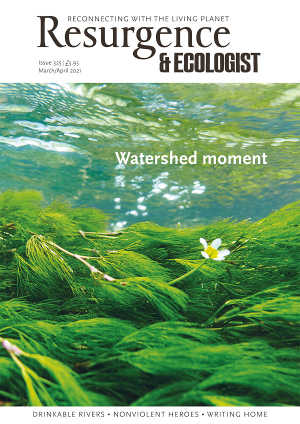In the second act of Hamlet, Shakespeare wrote that there is “nothing either good or bad but thinking makes it so”. I have always loved the idea that you can choose whether something will affect you in a certain way – whether to be angry or kind, whether the cup is half full or half empty. It’s harder to take the positive view in the face of climate breakdown, but nonetheless I have recently been allowing myself to feel hopeful for the first time in a long while. I hadn’t acknowledged how deeply rooted my eco-anxiety was, building slowly and steadily for the last decade or so, and it was only when the US election results came through that I saw how low the last few years had brought me. But with the election came the recognition that there was still a huge movement of people who believed in a brighter future, and I realised how Nature, like hope, needed only an inch of breathing space to push through the cracks and bloom again.
Judith D. Schwartz writes about the power of perspective in The Reindeer Chronicles, a book that takes us on a global tour of some of the most ecologically damaged places on Earth, and introduces us to the people who are successfully restoring them. She recalls hearing about a workshop facilitator who was working with a group of tribal leaders in Mali to increase food production. Asked whether they thought they could manage a 50% increase without western technology, they immediately said no, it was impossible. The facilitator then asked what they would do if it were possible. Without the pressure of their entrenched beliefs, the participants came up with several ideas, and by the time the facilitator visited them 15 months later food production had increased by 78%.
How many of us have heard a friend or relative ask, “What’s the point in trying to save the planet? We’re all doomed anyway”? The psychology behind this is fascinating, especially as what they’re saying simply isn’t true. We have all the resources we need to restore the environment to a healthy state and protect human society along the way, yet some still choose to surrender to despair – or relinquish responsibility. Schwartz writes passionately about an alternative view that shows us how a harmonious relationship with Nature is not just a dream for the distant future, but a reality that is already taking shape. She takes us from a soil-restoration project on China’s Loess Plateau to a desertification reversal in the Middle East, as well as to northern Norway to hear how Indigenous reindeer herders are trying to work with the government to conserve the fragile Arctic ecosystem. With echoes of Robin Wall Kimmerer’s Braiding Sweetgrass, we also hear how Indigenous women in Hawaii are pushing back against decades of social and ecological damage from the sugar industry. Above all, Schwartz advocates for communication over combat, demonstrating how an open mind can be the most powerful force for change.
Cal Flyn’s Islands of Abandonment takes us on an anthropocentric journey to some of the eeriest places on Earth, once inhabited by humans but now left to be reclaimed by Nature. Hope is alive in both books, yet Flyn weaves it through with a poetic understatement, hidden in the text, just as Nature is hidden, yet very much alive, within the polluted landscapes she visits. One of the difficulties with envisioning a greener future is that we sometimes accidentally imagine the past instead – a Wordsworthian idyll, free of plastic and pesticides. I know I’m guilty of comparing the present day with an imagined past, but this isn’t a realistic approach to a better future. As Robert Macfarlane showed us in Underland, we have left traces in the earth that cannot be erased. We must forge a new path for ourselves, accepting what we have done, working with what is left, and creating something new for our children to inherit.
Islands of Abandonment is a manifesto for this idea, finding the beauty in once desolate places and reminding the reader that there are few disasters Nature cannot recover from, if given time and space to heal. Flyn discovers a radioactive wilderness in Pripyat, toxic waterways in New Jersey, abandoned botanical gardens in the mountains of Tanzania, and a Scottish island ruled by free-roaming cattle abandoned when the last human inhabitants left for the mainland. Each location is permanently scarred, haunted by human industry, but amongst the debris Nature is reclaiming its territory. These places also offer respite in an era when human development seems to have spread to every corner of the globe. We are reminded that, no matter how populous we seem, and how few spaces remain untouched by human civilisation, we can disappear almost as quickly as we arrived.
Both The Reindeer Chronicles and Islands of Abandonment offer ecological hope for the Earth and every organism that still calls it home. Schwartz’s upbeat, solution-focused narrative differs from Flyn’s more stoic, poetic approach, but in the end they are both love letters to living things, encouraging us to believe in the combined power of human intelligence and Nature’s resilience. We are invited to see that change is possible when we allow ourselves to hope. As both authors’ research shows, we can help Nature and humanity to thrive, but first we must let go of the past, learn from the present, and embrace a brave new future.







